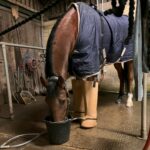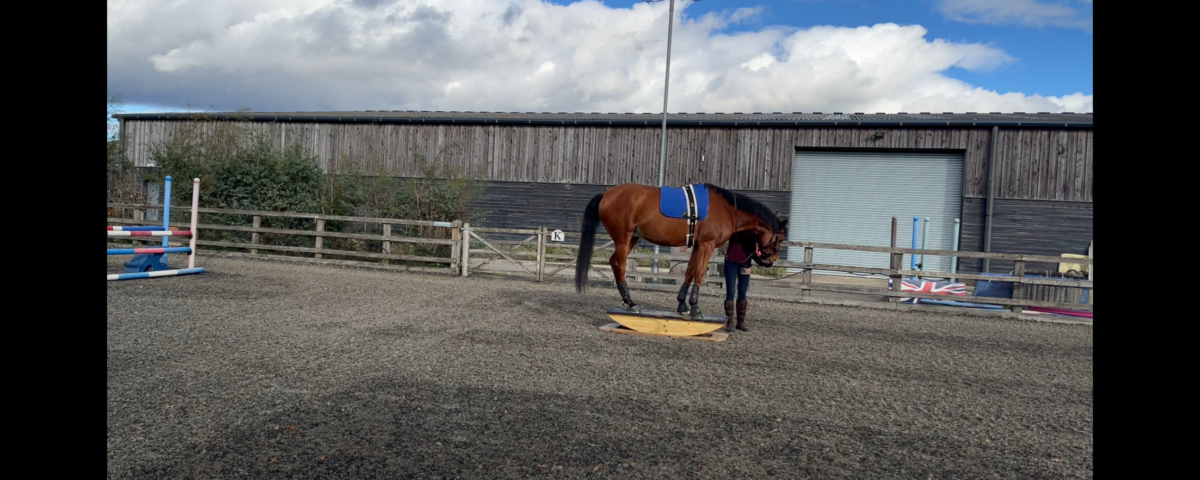
A cold therapy for horses that works
November 26, 2023‘Necessity is the mother of invention’, in this case, wobble boards already exist, but they are hard to find despite all the benefits, remain underutilised. We found this simple and brilliant training tool in the search of products and therapies to help Hugo with his chronic lameness issues consequent to navicular. For him it was a game-changer.
Horse training is an art that combines skill, patience, the right tools and help. We have come to understand that conventional methods only creates conventional outcomes. With Hugo, we had to be creative to do better than that. In this post, we’ll delve into why incorporating a wobble board into your horse training routine could be a game-changer for your horse too.
Benefits
Improving Balance and Coordination
The primary benefit of a wobble board is its ability to improve a horse’s balance and coordination. This helps them develop better proprioception, which refers to the ability to understand the position of limbs in time and space and move limbs with control. This develops with wobble board training as a consequence of standing on an unstable surface forces the brain to engage core muscles to stabilise to stay upright. Horses, like humans do not like being out of balance, and as soon as the board moves, the horse’s brain counter the movement with its body to maintain balance.
Muscle Strengthening and Conditioning
Regular use of the wobble board promotes muscle development around crucial areas such as the joints and ligaments, back, and abdomen. This muscle strengthening is vital for preventing injuries, facilitating recovery and further developing your horse’s talents. If you are struggling with topline and balance – this might just be the thing that helps develop the muscles that your horse is needing.
Rehabilitation and Recovery
The wobble board is an excellent tool for rehabilitation, helping injured horses recover by gently rebuilding strength and balance. It is also a form of gentle exercise that does not involve high impact. Impact from conventional exercises such as hacking, schooling and lunging all involve varying levels of impact, depending on the surface. Impact is necessary for regenerating cells, and can be good for ligaments and bones. However, for some horses, particularly with poor conformation of the feet, are really not ideal and does more harm than good.
Versatility in Training
The wobble board is a different form of training to conventional exercises that you do with your horse, such as lunging, schooling and hacking. All providing different benefits for horses. Wobble board training is a challenge that stimulates your horse’s mind and body, and facilitates the bond between you and your horse. Stepping on a wobbling surface require trust and during the process improves your horse’s confidence.
Our Journey
We started with balance pads to gently introduce balance training. These pads are widely available and relatively inexpensive, easy to use, but not effective enough for what the effect we were searching for. We bought ours from amazon.
Balance pads can be placed on a pair of legs, all legs or a singular leg. They can be stacked and cut into shape. A smaller surface makes them slightly ‘wobblier’ but harder to get your horse to keep its legs on. We started with one leg at the time, then a pair of legs. Increasing the time on it gradually.
From the video, you can see a bit of movement involved.
For more movement, we introduced a small wobble board, which can be used horizontally or vertically to target different muscle groups. Introduce one leg at the time and gradually to both legs. It can be use for the front legs or hindlegs, whichever you are interested in targeting.
Then we started with the traditional horse rocker, rewarding every motivation and interest in the wobble board to encourage Hugo to explore himself.
First the aim was simply for him to touch the wobble board, then step one leg, then two, then walk over it, then step one hind leg, then two, then the full body.
Learning how to rock on the board involved us encouraging Hugo to shift balance front to back and back to front. The simplest way to do this was to use rewards for moving head and neck downwards and inwards, and then gently pushing his weight backwards without him stepping off.
